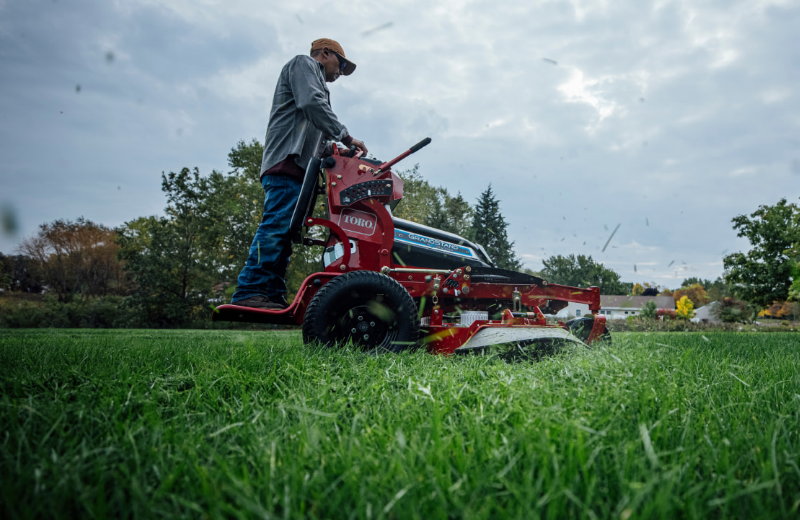How to Calculate ROI on New Electric Turf Equipment
editProperty and turf managers, landscapers, and others who take care of expansive outdoor spaces are increasingly adding electric turf equipment, such as the Toro Revolution Series, to their arsenal of tools. They’re finding making the switch to electric not only reduces their environmental footprint but also helps them achieve long-term cost savings.
One of the key questions we at Kenney Machinery see from customers interested in new electric turf equipment has to do with what kind of return on investment (ROI) they can expect. There are several considerations when determining if the ROI of a purchase is worth the investment.
Here is a closer look at how this breaks down for electric mowers, utility carts, blowers, and the like.
Understanding ROI
Return on investment is a crucial metric that assesses the profitability of an investment relative to its cost. In the context of electric turf equipment, ROI encompasses factors such as fuel and maintenance cost savings, environmental benefits, and potential incentives or rebates. Let’s examine each one.
Initial Investment
The first step in calculating ROI is determining the upfront cost of transitioning to electric turf equipment. This includes the purchase price of electric mowers, trimmers, blowers, other tools, and any additional infrastructure, like charging stations.
Operating Cost Savings
One of the primary advantages of electric equipment lies in lower operating costs compared to traditional gas-powered alternatives. Calculate the annual fuel and maintenance expenses of your current equipment and estimate the potential savings with electric alternatives (how much does it cost to power a gas mower with fuel vs. the electricity needed to charge an electric
mower).
Electric turf equipment requires less maintenance, has fewer moving parts, and eliminates the need for fuel, resulting in substantial long-term cost reductions.
Environmental Benefits
Beyond financial gains, electric turf equipment contributes to a healthier environment. Consider quantifying the environmental impact of reduced engine exhaust emissions, noise pollution, and the elimination of oil and fuel spills. Some ways to do this include:
- Calculate the reduction in carbon emissions by comparing the emissions from traditional gas-powered equipment to those of electric alternatives.
- Assess the impact on air quality by examining the reduction in air pollutants emitted by gas-powered equipment. This may include nitrogen oxides (NOx), carbon monoxide (CO), and volatile organic compounds (VOCs). Look into local air quality data and models to estimate the positive effects on the environment.
- Evaluate the conservation of natural resources resulting from reduced fuel consumption and the elimination of oil and lubricants. Quantify the potential savings in terms of oil extraction, processing, and transportation, as well as the conservation of non-renewable resources.
Additionally, many consumers today prioritize environmentally friendly practices, and showcasing your commitment to sustainability can enhance your brand image. This can result in increased business and consideration among your target markets.
Incentives and Rebates
Research available incentives and rebates offered by government agencies or utility companies for adopting electric equipment. These can significantly offset the initial investment costs and accelerate the payback period.
Increased Productivity
Electric turf equipment often requires less downtime for maintenance and refueling, contributing to increased productivity. Factor in the potential revenue gains from enhanced efficiency and reduced equipment downtime.
Also take into consideration the amount of area you can cover with a single charge of your equipment, such as a battery-powered mower. Is it comparable in speed, cut quality, and performance for the run time as what you would get with a gas mower? If so, you have increased productivity.
Calculating ROI
The ROI formula is relatively straightforward:
ROI = (Net Profit from Investment ÷ Cost of Investment) x 100
To calculate net profit from investment, figure out your total savings (operating cost savings + environmental benefits + increased productivity + incentives) and subtract your initial investment cost. Plug those numbers into the equation above to determine the percentage return on your investment.
A positive ROI indicates that transitioning to electric turf equipment can be financially beneficial over time. Though you may need to speculate a bit to come up with quantifiable values, a ballpark number can still give you a general idea as to whether there is enough ROI potential to make adding battery-powered equipment worth your while.
Kenney Machinery Can Help You Go Green
Calculating the ROI on new electric turf equipment is a strategic process that goes beyond immediate cost considerations. By factoring in long-term savings, environmental benefits, and potential incentives, property managers, landscapers, and turf managers can make informed decisions that align with both financial and sustainability goals.
As the green industry continues to evolve, Kenney Machinery is here to help you make investing in electric turf equipment not just a step toward modernization, but a leap towards a greener and more profitable future for your business.
Contact us today to learn more about Toro’s Revolution Series of electric mowers and turf equipment and how you can go greener today.

